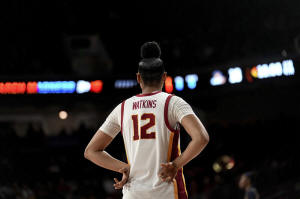There's no one-and-done path in
women's college basketball. And NIL money makes that a good thing
[April 03, 2025]
By TIM REYNOLDS and ALANIS THAMES
Paige Bueckers is widely expected to become the first WNBA No. 1
overall draft pick from the University of Connecticut since Breanna
Stewart nine years ago. Both became can’t-miss stars in college,
both are UConn icons, both went to four Final Fours.
Stewart did it while making nothing. Bueckers, who has UConn in the
Final Four for the second straight year, has done it while making
millions. And she's far from the only one cashing in right now.
There’s no one-and-done path to the WNBA for women’s players like
there is for men, who can jump to the pros after one year of college
regardless of age. Duke's standout freshman, Cooper Flagg, for
example, is expected to go No. 1 in the NBA draft and he just turned
18 in December.
The NBA and WNBA have different rules regarding draft eligibility.
For years, that impeded how and when women’s players could start
making money. The name, image and likeness era of college sports has
changed just about everything, leveling the playing field in some
respects for female athletes like Bueckers and allowing her to have
deals with Nike, Gatorade and other sponsors while still wearing
UConn colors.
“I think Paige is the poster child for how it’s supposed to be,”
coach Geno Auriemma said. “That’s the way it’s supposed to work. She
came out of high school at a time when people weren’t just getting
paid to play. … She made a name for herself and set a standard for
exactly why you’re supposed to be able to appreciate this stuff. You
go to college. You’re the best player in the country, and everybody
wants to be associated with you, and the school doesn’t give you a
dime.”
To jump to the WNBA draft, players must either be a senior with all
college eligibility exhausted or turn 22 in the draft year and
renounce any remaining eligibility.

Yet there is no clamoring to change the women’s rules because,
frankly, it wouldn’t make much sense under the current salary
structure. The No. 1 pick in this year’s NBA draft will make
somewhere around $13.8 million in his rookie season. The No. 1 pick
in this month’s WNBA draft will make $78,831 in her rookie season.
Smart business for women's players to stay in school
Staying in school isn’t a bad thing for women’s players. It’s smart
business. NIL deals will follow many of them to the WNBA. But the
pro check isn’t exactly a game changer for those at the top of the
women’s game. The top current WNBA base salary is around $242,000,
though that's expected to increase with the recent financial boom in
women's sports.
Former Miami guards Haley and Hanna Cavinder became the first faces
of the NIL era in college sports when it started on July 1, 2021,
while they were still at Fresno State. They were immediately
featured on a billboard in Times Square, the new faces of Boost
Mobile. College sports were immediately changed.
The Cavinder twins have built a multimillion-dollar fortune and have
more than 7 million followers across their Instagram and TikTok
accounts. They’ve never confirmed actual numbers, but it's
reasonable to believe the Cavinder twins are among the top-paid
college athletes given both their earnings and equity stakes in
various companies. Their college careers ended last month.
“I think we were pretty naive in the beginning with it, honestly,”
Haley Cavinder said. “To be transparent, I don’t think Hanna and I
really knew. We had talks of what NIL was, and I always saw tweets
about it. But I never really envisioned myself getting paid or Hanna
getting paid until July 1 happened. And then I was like, ‘Wow, this
is overwhelming.’ I didn’t know how much money there was.”
[to top of second column] |

Southern California guard JuJu Watkins stands on the court during
the second half against UNC Greensboro in the first round of the
NCAA college basketball tournament Saturday, March 22, 2025, in Los
Angeles. (AP Photo/Eric Thayer)

Olivia Miles, who starred at Notre Dame for four
seasons, was widely expected to go between No. 2 and No. 4 in this
month’s WNBA draft. Instead, she decided to enter the transfer
portal and play one last college season — taking her lucrative NIL
deals with her wherever she ends up and missing out on the $78,000
WNBA payday for the 2025 season.
Same goes for Southern California's JuJu Watkins, perhaps the most
talented player in the women’s game. Her season ended with a torn
ACL in the NCAA Tournament, but her NIL deals will live on and could
even grow by the time she returns to the court — presumably sometime
next season. There’s no urgency for her to go pro, since her earning
stream already exists.
Female college athletes ‘most effective media buy in sports’
Opendorse, a company that provides NIL services to dozens of
schools, has data that might be shocking to some. It shows that top
women’s programs have a combined social media following that exceeds
that of the top men’s programs, which is a clear factor in
determining NIL value.
While the numbers of those engaging with top men’s programs on
social media skew about 4-to-1 male, it’s close to a 50-50 split
when charting those engaging with women’s basketball stars and
teams.
“Female student-athletes are probably the most effective media buy
in sports right now,” Opendorse CEO Steve Denton said. “And
everything I see in the data tells me that, which is that their
social audiences are three times as large as the average social
audience. ... They’re just better at it in terms of — they curate
their social feeds better than the men do.”
The opportunities afforded by NIL were certainly a reason why
Bueckers chose to stay in college. Same goes for Miles.
It was one of the reasons why Kate Martin was in no hurry to leave
Iowa and end her time as teammates with Caitlin Clark — who
obviously played a major role in the explosion of women's basketball
in recent years. Martin was in college for six years. When she got
there, NIL didn’t exist. When she left, people were paying money to
wear things bearing her name.
“To get my education paid for and then to be able to capitalize and
make a little bit of money off of my NIL, I thought was huge,” said
Martin, who’s going into her second WNBA season. “And so that was
one of the main reasons why I decided to stay.
"So, I don’t blame people. You know, I would get made fun of because
I was there for six years, but I didn’t really care. I wouldn’t be
where I am right now if I didn’t stay.”
All contents © copyright 2025 Associated Press. All rights reserved
 |